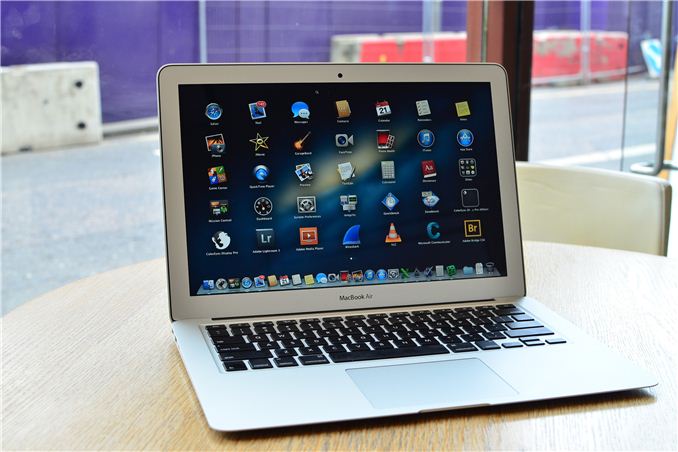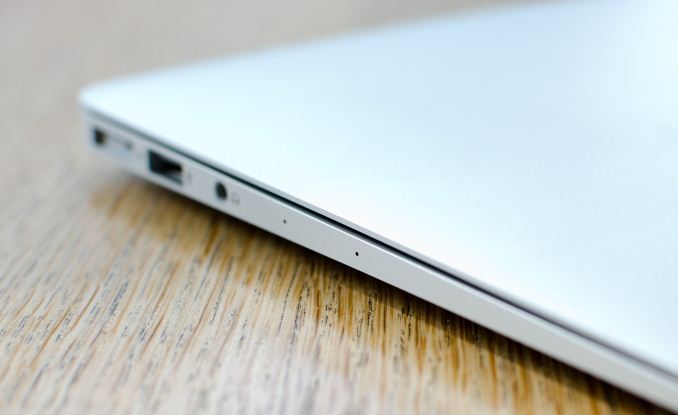The 2013 MacBook Air Review (13-inch)
by Anand Lal Shimpi on June 24, 2013 12:01 AM EST
Things didn’t go exactly as I’d expected at WWDC. I spent the week before the show at Computex, talking to PC OEMs, who had all just launched their Haswell ULT based Ultrabooks. With a couple of exceptions however, the bulk of Haswell ULT systems weren’t scheduled to ship until later this year. Even the Acer S7 I snagged while in Taipei was still a pre-production unit, with final hardware due out in the next month. Based on what I saw in Taiwan, and Intel having seeded me an Iris Pro machine the week before, I assumed that the MacBook Pro with Retina Display is what would get the Haswell treatment first. Obviously, that didn’t happen.
In hindsight, the move makes sense. Apple will sell far more MacBook Airs than rMBPs. The Apple/Intel relationship is looking very healthy these days, so it’s also not surprising that it would have supply and early enough access to Haswell ULT to launch the MBAs at WWDC with almost immediate availability. The Haswell ULT shift didn’t require a new chassis for Apple, which meant a less complex development process.
From the outside, the new MacBook Air looks nearly identical to its predecessor. There's a second mic opening on the left side of the machine now, but otherwise you'd be hard pressed to tell this year's model apart from the previous generation. Internally, nearly everything has changed.
The battery is higher capacity, with no increase in weight. Making better use of that larger battery is Intel's new Haswell ULT silicon. Since we're talking about a ULT part, the PCH moves from the motherboard to the CPU package - creating an emptier motherboard than we've seen in previous years:
The 2013 13-inch MacBook Air Motherboard, Courtesy iFixit
It's clear to me that the MBA is due for a more significant redesign, but this is not the year for that.
Alongside Haswell comes a brand new PCIe SSD, 802.11ac support and LPDDR3 memory. All at a price equal to, if not less than last year's models:
| 2013 MacBook Air Lineup | ||||||
| 11.6-inch | 11.6-inch (high-end) | 13.3-inch | 13.3-inch (high-end) | |||
| Dimensions |
H: 0.11-0.68" (0.3-1.7cm)
W: 11.8" (30cm) D: 7.56" (19.2cm) |
H: 0.11-0.68" (0.3-1.7cm)
W: 12.8" (32.5cm) D: 8.94" (22.7cm) |
||||
| Weight | 2.38 lbs (1.08kg) | 2.96 lbs (1.35kg) | ||||
| CPU | 1.3GHz dual-core Core i5 | 1.3GHz dual-core Core i5 | ||||
| GPU | Intel HD 5000 | |||||
| RAM | 4GB LPDDR3-1600 | |||||
| SSD | 128GB PCIe SSD | 256GB PCIe SSD | 128GB PCIe SSD | 256GB PCIe SSD | ||
| Display Resolution | 1366 x 768 | 1440 x 900 | ||||
| Ports | Thunderbolt, 2x USB 3.0, headphone jack | Thunderbolt, 2x USB 3.0, SD card slot, headphone jack | ||||
| Networking | 2x2:2 802.11ac | 2x2:2 802.11ac | ||||
| Battery | 38 Wh | 54 Wh | ||||
| Price | $999 | $1199 | $1099 | $1299 | ||
We've been over the MacBook Air chassis thoroughly in the past so I won't go through it again here. Build quality remains excellent. The clickpad and backlit keyboard never give me any troubles either. It's sad that we're still having clickpad issues elsewhere in ultraportables but this is one area where Apple's vertically integrated advantage is apparent (as is the company's willingness to spend a little extra on even the little details).
The only thing that hasn't changed, that perhaps should have is the display. The MacBook Air retains the same 1366 x 768/1440 x 900 panels from last year, while much of the competition has moved to at least 1080p IPS in the 13.3-inch form factor. This year at Computex we saw a number of systems move to 2560 x 1440 13.3-inch panels, at least as an option, however I'm expecting those systems to be priced more in line with the 13-inch rMBP rather than the MacBook Air. Admittedly, I don't know the right solution here.Ultra high resolution panels drive cost and power consumption up, the latter which can be offset by going to a larger battery - but then you have a 13-inch rMBP. Perhaps the right move for the MacBook Air would be for Apple to move to IPS panels at least? Or maybe we see a merger of the 13-inch MBA/rMBP, and something new entirely replace the 11-inch model.












233 Comments
View All Comments
darwinosx - Monday, June 24, 2013 - link
They are not biased and you don't understand the meaning of the word.MonkeyPaw - Monday, June 24, 2013 - link
Just a thought, but how about stating your concerns via constructive criticism or in the form of a question. Crying bias while continuing to visit (and therefore, support) any website just doesn't make much sense since you will be dismissed as a troll by the very people you are hoping to influence.CalaverasGrande - Monday, June 24, 2013 - link
Frankly I think users that expect to play heavy 3D games on a MacBook Air with chipset video bought the wrong computer. They should have spent a few hundred more for a 15" MBP with discrete graphics. Or if they really care about games they should hop the fence and go get an Asus or some other Windows gaming notebook.Intel's HD4000 graphics are better than previous Intel video attempts, but still pretty weak compared to other vid chips. It's also using system ram, not dedicated ram.
As stated, this is the mobility platform, not the performance platform.
CalaverasGrande - Monday, June 24, 2013 - link
oops, HD5000.darwinosx - Monday, June 24, 2013 - link
Nobody does. But the HD 5000 is quite capable for some games.hyrule4927 - Monday, June 24, 2013 - link
The lack of thermal data in these Mac reviews is rather frustrating. If this data is included in all other PC reviews in Anandtech, why is it completely ignored when reviewing Apple products? They certainly aren't immune to heat/throttling problems.darwinosx - Monday, June 24, 2013 - link
You didn't read the article you are commenting on.hyrule4927 - Monday, June 24, 2013 - link
If you would like to tell me where specific CPU temperature data is given, be my guest. All I see is an anecdote about fan noise and speculation about throttling in several tests.darwinosx - Monday, June 24, 2013 - link
Prove that Samsung makes a better screen than LG. I bet you can't tell the difference.spronkey - Monday, June 24, 2013 - link
Samsung LCDs might have slightly better early quality control. LG Display have been a bit notorious for early run issues with their panels lately. But I agree - taking these away, LG has more cred as a panel maker than Samsung does.